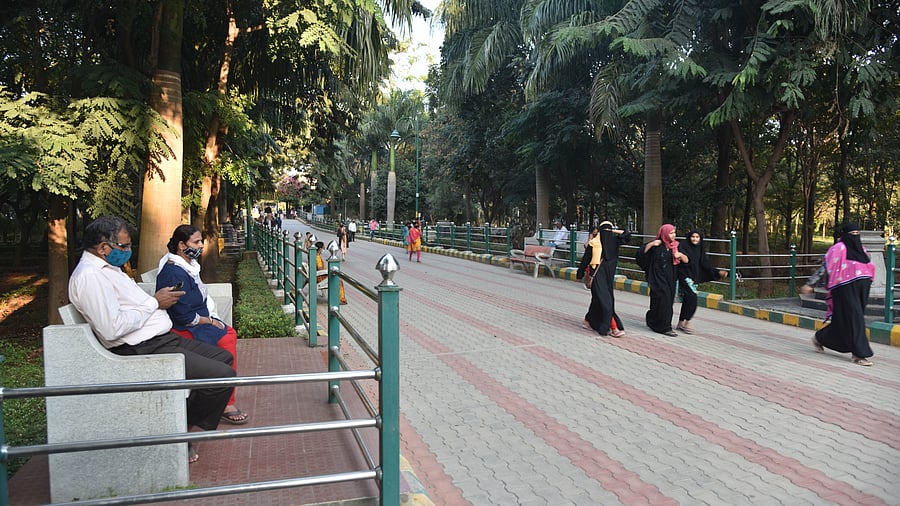
JP Park is one of the popular lung spaces in RR Nagar assembly constituency, which has the highest number of parks in Bengaluru.
Credit: DH Photo/B K Janardhan
Bengaluru: As Bengaluru aspires to be counted among the leading cities in the world, the lack of open spaces – particularly in the eastern suburbs where multinational companies are situated – remains one of its many drawbacks.
While issues such as traffic congestion, broken roads, flooding, etc are commonly discussed, most elected representatives have not acknowledged the importance of neighbourhood parks, which support both biodiversity and serve as community spaces for social and physical activities.
Despite being known as the ‘Garden City’, Bengaluru has only 1,240 neighbourhood parks in the BBMP limits (barring Cubbon Park and Lalbagh). In comparison, New Delhi has over 14,000 such lung spaces.
A majority of the parks in Bengaluru are situated in layouts that were developed by the Bangalore Development Authority and handed over to the BBMP for upkeep. This indicates the absence of efforts from the BBMP, corporators and MLAs in developing new parks in pockets (revenue sites) which grew organically without any planning.
Of the total neighbourhood parks in Bengaluru, constituencies such as Chickpet, Gandhinagar and Pulakeshinagar have fewer than two dozen parks each. Worse is Chamarajpet with only 10 parks. While these constituencies are Bengaluru’s oldest residential neighbourhoods with a thick population and smaller geographical boundaries, what catches the eye is the number of neighbourhood parks in assembly segments such as KR Puram and Mahadevapura.
According to the BBMP, there are just 21 parks in KR Puram, which has a voting population of nearly 5 lakh, and 24 parks in Mahadevapura, one of the largest assembly constituencies both in size and population.
To put this in perspective: the BDA has earmarked over 550 neighbourhood parks in Dr Shivaram Karanth Layout, which is coming up in North Bengaluru on a 3,400-acre land. This was, however, possible as the project is being monitored by the Supreme Court-monitored committee.
Misuse of 15% clause
Urban planners and active residents pin the blame on local legislators and the town planning department officials of the BDA and the BBMP. As per the rules, at least 15 per cent of the total area of a layout should be reserved for public parks and playgrounds and an additional 10 per cent for civic amenities. This rule has, however, been mostly compromised by the builders.
A member of the Whitefield Rising civic group said basic amenities in Mahadevapura, including open spaces, toilets or road length, are lower than any standard parameters. “Our constituency has a lot of public lands but there is either lack of funds or political will in making use of these properties for the public good,” he said, adding unauthorized layouts – comprising anywhere between 15 to 100 sites – are mushrooming even today.
“The builders neither have plan sanction nor relinquish the common amenities. On top of this, they get A-khata certificates,” the member said, detailing how the town planning department is turning a blind eye to illegalities.
Clement Jayakumar, a member of the Mahadevapura Task Force, said other constituencies have more parks as they have BDA-developed layouts including Bommanahalli (HSR Layout).
“Just 15 years ago, Mahadevapura was not even part of the BBMP. The shortage of open space is a town planning subject, which is beyond the MLA’s scope of work. The officers act only when there are instructions from the concerned ministers,” he said.
KR Puram MLA Byrathi Basavaraj acknowledged that there are fewer neighbourhood parks in his constituency. “I want to create new parks but there is no land. The shortage of such parks is also because the constituency is full of revenue site holders. We do not have many approved layouts,” he said.
His opponent D K Mohan Babu, who lost by a slim margin in the last polls, squarely blamed the lack of political will and vision on the part of the MLA. “Barring a few parks next to lakes, there is no place where residents can walk or spend time. Most of the government properties have been encroached upon or diverted for unimportant purposes,” he said. He also named three government properties in KR Puram which could be developed as parks: 14-acre land in Bhattarahalli, 4-acre in Babusapalya and 17-acre property in Kothanur.
Harini Nagendra, professor of ecology at Azim Premji University, said neighbourhood parks were important pockets of green spaces within cities. “One can easily see hundreds of people squeezing into tiny parks even in places like Jayanagar, JP Nagar and Basavanagudi. Some neighbourhood parks are as small as 300 metres in perimeter but these lung spaces attract children, women and senior citizens. Some form large groups and socialize in the park but the authorities have not taken enough steps to ensure these parks are distributed equitably,” she said.